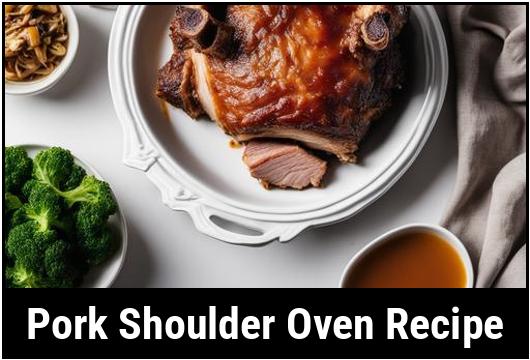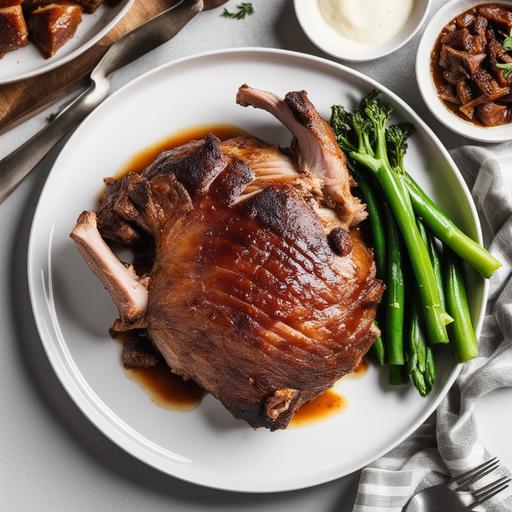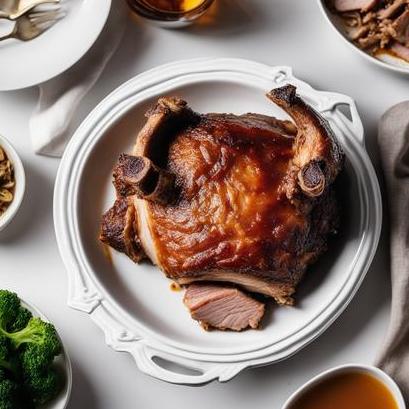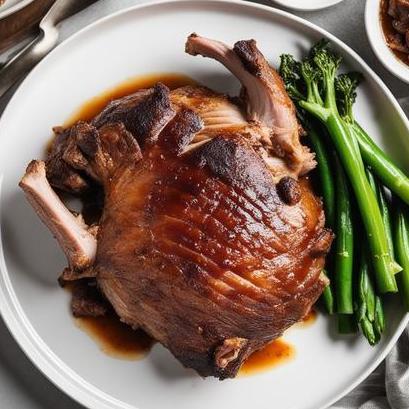
Pork Shoulder Oven Recipe: A Comprehensive Guide
Pork shoulder is a versatile cut of meat that is perfect for slow-cooking in the oven. When cooked properly, the result is juicy, tender, and flavorful meat that can be used in a variety of dishes. In this article, we will explore the food science behind this cut, culinary techniques, selection and cleaning, preparation, tips, variations, doneness checks, recipe, and more.
Food Science Behind Pork Shoulder
Pork shoulders are cut from the upper portion of the pig’s front leg and shoulder blade. This area contains a lot of connective tissue, which means it requires a longer cooking time to break down properly and become tender. However, as the pork cooks, the connective tissue breaks down and becomes gelatin, which delivers that perfect, melt-in-your-mouth texture that makes pork shoulder so irresistible.
Selection and Cleaning
When selecting pork shoulder, look for a bone-in or boneless piece that is evenly shaped and has a good layer of fat. The fat will help keep the meat moist and increase the flavor. When cleaning the meat, rinse it under cool water and pat it dry with paper towels.
Preparation

Before cooking, it’s important to season your pork shoulder. A rub or marinade is a great way to add flavor to the meat. You could also inject seasoning or a brine to get the flavor deep into the meat. Once seasoned, let the pork shoulder sit at room temperature for about 30 minutes before cooking to allow the meat to come to room temperature.
Culinary Techniques

There are two primary techniques for cooking pork shoulder, low and slow slow-roasting and braising.
Low and Slow Roasting
Roasting is a great option if you want to surround the meat with dry heat. You’ll need to cook it low and slow to allow the pork to become tender and juicy without drying out. Start by preheating your oven to 325°F. Place your seasoned pork shoulder in a roasting pan and cook for about 4-5 hours, depending on the size of the roast. It’s essential to let the roast to rest for 15-30 minutes before slicing.
Braising
Braising is an ideal method for cooking pork shoulder if you want a rich and flavorful meal. To braise your pork shoulder, set your oven to 350°F. Place your seasoned pork shoulder in a Dutch oven or other large pot with a lid. Add some liquid, such as stock or wine, to the pot. Cover the pot and cook for about 3-4 hours, or until the meat is falling off the bone.
Tips and Variations

Here are some tips and variations to help you get the most out of your pork shoulder oven recipe.
Use a Meat Thermometer
Using a meat thermometer is crucial when cooking pork shoulder. The internal temperature must reach 190°F to be sure that the meat is done.
Don’t Overcook
Overcooked pork shoulder can be dry and tough. It’s essential to take it out of the oven when it reaches the desired internal temperature. Once out of the oven, let the meat rest for a few minutes before slicing.
Variations
There are plenty of variations to pork shoulder that you can experiment with, such as adding different spices, herbs, or liquid. You could also try different cooking times and methods to find your favorite flavor.
Recipe

Here’s a simple recipe for pork shoulder using the low and slow-roasting technique.
Ingredients
-
1 bone-in pork shoulder, about 6 lb
-
2 tablespoons olive oil
-
2 tablespoons paprika
-
2 tablespoons kosher salt
-
1 tablespoon black pepper
-
2 teaspoons onion powder
-
2 teaspoons garlic powder
-
2 teaspoons cumin
-
1 teaspoon smoked paprika
Method
-
Preheat your oven to 325°F.
-
Rinse your pork shoulder with cool water and pat it dry with paper towels.
-
Combine the paprika, kosher salt, black pepper, onion powder, garlic powder, cumin, and smoked paprika in a small bowl.
-
Massage the olive oil onto the pork shoulder and sprinkle the spice mixture over the entire roast.
-
Place the pork shoulder in a roasting pan and cook for about 4-5 hours, or until the internal temperature reaches 190°F.
-
Remove the roast from the oven and let it rest for 15-30 minutes before slicing and serving.
Conclusion
Pork shoulder is a cut that can take on a lot of different flavors and techniques. Whether using slow-roasting or braising method, you can create a delicious and tender meal for your family and friends. With this comprehensive guide, we hope that you feel confident and excited to try new variations and techniques with your pork shoulder oven recipe.
Sources
FAQS On Pork Shoulder Oven Recipe
How Long Should I Cook A Pork Shoulder In The Oven?
The recommended cooking time for a pork shoulder in the oven is approximately 1 hour and 15 minutes per pound at a temperature of 325 degrees Fahrenheit. However, it is important to use a meat thermometer to ensure the internal temperature of the pork reaches at least 145 degrees Fahrenheit for medium-rare, 160 degrees Fahrenheit for medium, or 170 degrees Fahrenheit for well done.
Can I Marinate The Pork Shoulder Before Cooking It In The Oven?
Yes, marinating the pork shoulder before cooking can add flavor and tenderness to the meat. You can choose from a variety of marinades, such as a mixture of olive oil, garlic, herbs, and spices. Simply place the pork shoulder in a large resealable bag or container, pour the marinade over it, and let it marinate in the refrigerator for at least 4 hours or overnight.
Should I Sear The Pork Shoulder Before Roasting It In The Oven?
While searing the pork shoulder before roasting is not necessary, it can enhance the flavor and texture of the meat. Searing involves browning the pork shoulder on all sides in a hot skillet with a little bit of oil. This step helps to create a caramelized crust, giving the pork a richer taste. If you choose to sear the pork shoulder, do it before transferring it to the oven for roasting.
How Do I Know If The Pork Shoulder Is Fully Cooked?
To ensure the pork shoulder is fully cooked, it is vital to use a meat thermometer. Insert the thermometer into the thickest part of the meat. Once the internal temperature reaches at least 145 degrees Fahrenheit for medium-rare, 160 degrees Fahrenheit for medium, or 170 degrees Fahrenheit for well done, you can consider the pork shoulder cooked. Additionally, the meat should be tender and easily pulled apart with a fork.
Should I Let The Pork Shoulder Rest Before Serving?
Yes, it is highly recommended to let the pork shoulder rest for about 15-20 minutes after removing it from the oven. Resting allows the juices to redistribute, resulting in a juicier and more flavorful meat. Cover the pork shoulder loosely with aluminum foil to retain its warmth while resting. This step also makes it easier to carve or shred the pork for serving.


